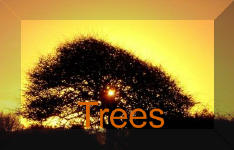Synyomns
Horse chestnut Conkers and the Horse Chestnut Tree
A conker within its fruit case
The "conker" season is upon us. "Conkers" are the seeds,
in the form of nuts, of the Horse Chestnut. They are used for the school-child's
game of the same name.
For non-UK readers unfamiliar with this autumnal pastime, players drill a hole through the middle of the nut or "conker", thread a string through, knot it and then proceed to take alternate blows at the opponent's "conker". The winner is the one who breaks the opponent's "conker".
First introduced to Britain from the Balkans in the late 16th century, it was not until about 200 years later that the fruits of the horse chestnut trees were used to play "conkers".Before that, "conkers" were played with hazel or cobnuts or snail shells.
"Conkers" are eaten by deer and cattle and in the past were sometimes ground up as meal to fatten sheep.
The Horse Chestnut
The horse chestnut's scientific name is Aesculus hippocastanum. It grows
naturally in the moist mountain valleys of parts of Albania and Greece.
In the UK, horse chestnuts have been grown as ornamental trees, particularly
in avenues or along roadsides for their spectacular "candles"
of white flowers all over the tree in the spring.
These trees are seen at their best when grown in the open reaching up to 35m (115ft) with the arching branches normally turned up at the ends. It is one of the largest flowering trees of the temperate world.
Leaves and flowers
The leaves are large and compound, in the form of a palm with the five
or six leaflets spreading out like the fingers of a fat hand. The leaves
fall in autumn to leave large horseshoe-shaped leaf scars
The flowers then give rise to the large globular green spiky fruit. These split open about September to reveal one to three large shiny, mahogany brown seeds or nuts - the "conkers".
In its adopted home in Britain, the horse chestnut grows rapidly on most soils but needs plenty of space to flourish.
Other species are found in North America where the glossy nuts appearing from the spiny shells give them the name of "buck-eye" as the chestnuts resemble the eye of a deer.
The pink and red flowered forms are hybrids between
the horse chestnut and red American buck-eyes. A new fruitless cultivar
is on the market for situations where the flowers are prized but people
do not want small boys throwing sticks and sundry missiles up into the
canopy to dislodge the best "conkers" to engage in combat with
their peers.

